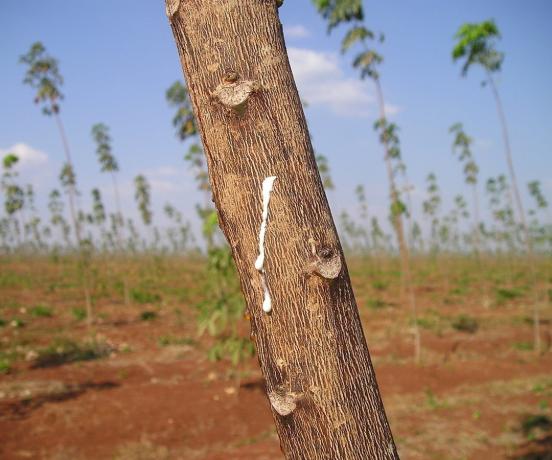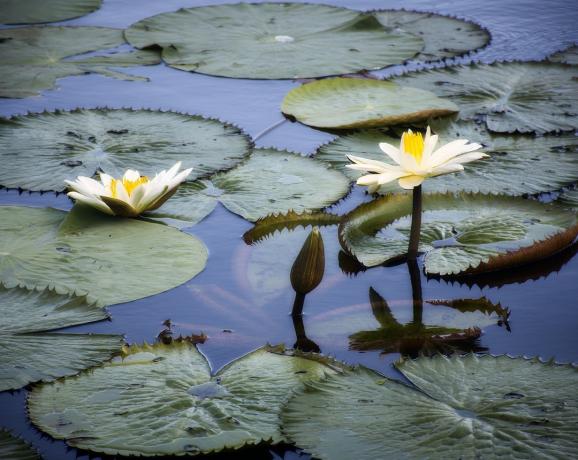The Amazon biome is classified as the largest and most diverse biome in the country, extending over almost half of the territory of Brazil.
In addition to being the largest in extension, it is also the richest, as it has numerous animal and plant species distributed throughout its extension.
The Amazon biome has a total area of about 6.9 million km2. In Brazil, it has about 4.2 km2, which represents 60% of the biome's area. In terms of population, it is estimated that the region covered is inhabited by 35 million people.
Where is the Amazon biome?
The biome is located in the northern region of the country, passing through nine states: Acre, Amazonas, Amapá, Mato Grosso, Maranhão, Pará, Rondônia, Roraima and Tocantins.
In addition to these Brazilian states, the Amazon also affects eight countries located in South America: Bolivia, Colombia, Ecuador, Guyana, Peru, Suriname and Venezuela.
 The Amazon is the largest biome in Brazil (Source: IBGE).
The Amazon is the largest biome in Brazil (Source: IBGE).
Characteristics of the Amazon Biome
The Amazon biome is characterized by its enormous biodiversity, that is, by the great variety in its fauna and flora. It also has a diversity of reliefs found. Its most important ecosystem is the
Amazon rainforest, the biggest in the world.Flora
The flora of the Amazon is formed predominantly by forest areas, with very tall and robust trees. It is estimated that between 30 and 40 thousand different species of plants, trees and flowers are part of the biome.
Some examples of native species in the region are: palm, water lily, guaraná, açaí, chestnut, Jatobá, mahogany and rubber trees.
 The rubber tree is a typical tree in the Amazon biome. The tree produces latex, which is used in the manufacture of rubber.
The rubber tree is a typical tree in the Amazon biome. The tree produces latex, which is used in the manufacture of rubber.
The vegetation found in the Amazon biome is classified into three types: terra firme, floodplain and igapó.
the forests of dry land they are located in regions with higher altitude and are characterized by taller and denser trees.
the forests of floodplain they are lowered areas, almost always close to rivers and that occasionally suffer floods. It is in this region that the Amazonian soil is richest in nutrients.
already the igapó forests are located in the lower regions of the biome and are constantly flooded. Therefore, the vegetation found is typical of flooding, such as water lilies - a typical species in the region.
 The water lily, which lives in the igapós, is one of the symbols of the Amazon.
The water lily, which lives in the igapós, is one of the symbols of the Amazon.
Also read about the Amazon rainforest.
Fauna
There are a multitude of animals that are part of this biome. Studies on the region indicate that there must be at least 30 million species in the Amazon fauna and some of these animals are not even known or registered.
The Amazon also has the highest concentration of different species of fish. At least two thousand types live and reproduce in the waters of the Amazon River.
Many mammals, birds, reptiles, amphibians, insects and fish are found in the biome. Some examples of these animals are: jaguar, anteater, monkey, toad, owl, sloth, capybara, ocelot, turtle, alligator, ant, arapaima, manatee, dolphin, parrot and toucan.
 The sloth is one of the typical animals of the Amazon fauna.
The sloth is one of the typical animals of the Amazon fauna.
Climate
The climate of the Amazon biome is characterized by the frequency of rainfall throughout the year, with an average exceeding 2000 millimeters per year.
Temperatures in general also have little variation and are usually between 23°C and 28°C. In some regions the change can be even smaller and the temperature does not vary by more than two or three degrees.
These characteristics make the biome's climate constant over the months and that's why the seasons of the year are also not very defined, as climatic variations are little noticeable. Furthermore, these characteristics provide the existence of such diversity in the biome.
The climate of the Amazon biome is classified as wet equatorial. Learn more about equatorial climate.
Relief
The biome relief can be classified as irregular, as it has different shapes. In the Amazon there are three main types: plateaus, plains and depressions.
 Plateaus, plains and depressions form the relief of the Amazon biome.
Plateaus, plains and depressions form the relief of the Amazon biome.
You plateaus are found in higher regions and have peaks of up to 300 meters.
At plains, on the contrary, are flatter regions and are located in lower altitude zones. In general, they do not exceed 100 meters.
At depressions they can be found in even lower regions and are often located at sea level. Depression is the lowest-altitude relief within the Amazon biome.
To know even more about the subject, see what are the relief forms and meet the brazilian relief.
Ground
The biome's soil is, for the most part, infertile and poor in nutrient concentration. The low fertility is due to the low amount of nutrients found in its soil.
This data may seem quite curious when we look at the variety of species in the biome. However, some factors, such as excessive rainfall in the region, can be pointed out as one of the reasons for soil poverty.
In general, only the outermost layer of the soil has a higher concentration of nutrients, which are mainly derived from the decomposition processes of the region's fauna and flora.
But there is fertile soil in part of the Amazon: in the regions closest to rivers or watercourses. It is believed that the water itself carries large amounts of nutrients from other regions, making the soil in these areas richer than in other areas.
Also read about the Brazilian biomes, O thick, and meet the Legal Amazon and the Amazon International.

